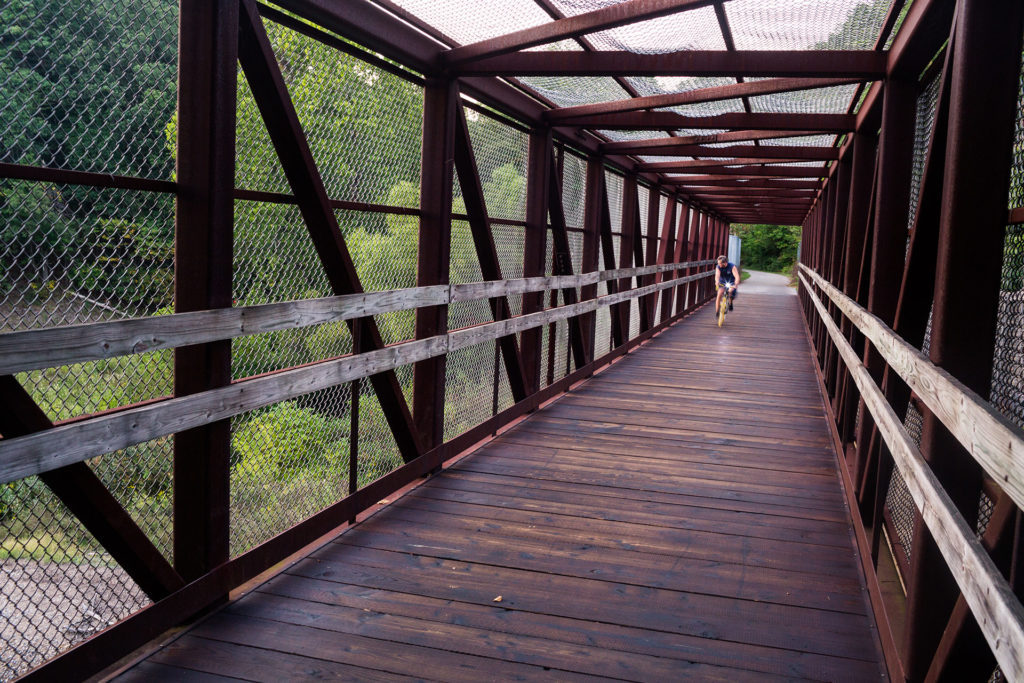Paddling, Peddling, Picnicking and Photographing the Outdoors of Montgomery County
Whether by land or water, there are abundant opportunities to explore nature and seek adventure in Montgomery County.
The Huckleberry Trail connects towns of Blacksburg and Christiansburg and is part of the nation’s rail-to-trail system, making the 14-mile trek perfect for outdoor enthusiasts of all ages and abilities, whether walking, running or cycling. The Renva-Knowles Memorial Bridge along with multiple trail heads along the way afford visitors easy access and parking.

Along the way, you’ll encounter Coal Miner’s Heritage Park, located on a 30-acre swath of land where the Merrimac mining community once resided. Where a mining tipple, hotel, general store and residential housing for coal miners once stood is now an open greenspace and a wooden bridge leading guests into the park, the old mining entrance and some of the remnants of the old mining community. The park is an homage to more than 100 years’ worth of coal mining history in the region.
The adjacent Coal Mining Loop Trail, a newer addition to the Huckleberry Trail, was designed and built by volunteers from Pathfinders for Greenways, who dedicated nearly 2,000 hours to the project.
Framing the New River Valley terrain for millions of years, the New River is the ultimate playground for aquatic enthusiasts.
On and in the water
McCoy Falls is one of locals’ favorite spots along the New River for everything from leisurely sunbathing to thrilling water sports. The put-in at McCoy Falls was for several years the site of the New River Rodeo, a popular white-water competition that drew quite a crowd. Today, the site is a put-in for beginners of white-water boating, fishermen (and women) and tubers. The spot also is perfect for splashing around in the New River when the water’s warm enough and deep enough.
For those without their own river-worthy vessel, New River Junction is a family-owned campground and recreational park which offers access to the wide, shallow riffles and clear, warm waters of the ancient New River. Visitors can rent tubes (and a cooler) for the whole family and simply relax as they float down nearly one mile of calm water. For those seeking a bit more adventure, there is an optional 200 yards of exhilarating rapids at the end of the float.

Biking, hiking and more
Jefferson National Forrest is one of two forests (the other being Washington National Forest) that stretch across the entire state of Virginia, watched over by the beautiful Appalachians. Two thousand miles of hiking trails set among neo-tropical birds in the summer and a kaleidoscopic pallet of color during the crisp fall lend to some of the most breathing scenery in the region.
Other than hiking, visitors can enjoy the forest in whatever way their wanderlust desires, whether fishing, mountain biking, camping, hawk watching, cross-country skiing, horseback riding and photography.
Additionally, 330 miles of the internationally famous Appalachian National Scenic Trail, along with 160 miles of National Recreation Trails, call the forests home.
If mountain biking is your thing, be sure to drop in at the Pandapas Pond area, also located in Jefferson National Forest. Claimed as some of the best mountain biking trails on the east coast, mountain bikers can kick up mud over 19 trails and more than 30 miles of terrain. Trails are suitable for all skill levels from greenhorns to shredders, while rough rock gardens, switchbacks and grueling vertical climbs await all comers.

For safety, trail difficulty is marked with International Mountain Bicycling Association (IMBA)-designated signage at most trail intersections. Additionally, a "Muddy Trails Meter" at the Pandapas trailhead keeps riders informed of trail conditions, as it’s preferable to stay off the trails in poor conditions to prevent damage to the trails.
If you’d prefer a more leisurely ride (or hike), Poverty Creek Trail is the main multi-use trail at Pandapas Pond that features more gently rolling slopes across a 7.1 mile one-way trail, perfect for hiking, running, horseback riding, mountain biking, or just enjoying a picnic at the Pandapas Pond day area.
The pond itself sits on the Eastern Continental Divide and treats visitors to a serene vista of rhododendron, dragonflies, turtles, songbirds, and waterfowl.

Wildlife splendor
Heritage Community Park, 169-acre section of land situated among rural communities and is a must-see for those who revel in observing wildlife across a variety of habitats ranging from lush meadows to floodplains.
Among birds who are breeding residents of the park include the whip-poor-will, willow flycatcher, yellow-breasted chat and pileated woodpecker, with more than 120 species of birds having been documented at the site. The fall season is best for birding, due to migration. On any given day, visitors observe species such as the olive-sided flycatcher, blackpoll, palm and bay-breasted warblers, as well as migrant raptors.
The park is home to least four species of swallowtails butterflies, five species of whites and sulphurs, and 13 species of skippers, including Peck’s, tawny-edged, and Hobomok skippers.
And let’s not forget our amphibious friends. Frog and toad species include American toad, pickerel, green, and upland chorus frogs, spring peeper, and gray treefrog. Northern dusky salamanders can be found buried beneath rocks and logs along Tom’s Creek.
Heritage Community Park’s community of mammals includes long-tailed and least weasels, short-tail shrew, river otter, woodchuck, muskrat, bog lemming, red fox, and bobcat. Four species of bats, eastern pipistrelle, big brown, little brown, and red have also been seen at this site. Herp lovers might find black racer, queen, black rat, and eastern garter snakes.







